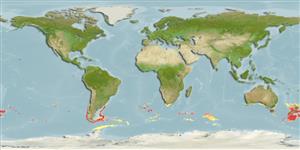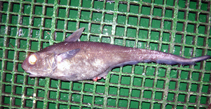Ajouter votre observation dans Fish Watcher
| Native range | All suitable habitat | Point map | Year 2050 |

|
| This map was computer-generated and has not yet been reviewed. |
| Macrourus carinatus AquaMaps Data sources: GBIF OBIS |
Envoyez vos Photos et vidéos
Pictures | Images GoogleMacrourus carinatus
Picture by Reyes, P.
Pictures | Images GoogleMacrourus carinatus
Picture by Reyes, P.
Common names from other countries
Classification / Names Noms communs | Synonymes | Catalog of Fishes(Genre, Espèce) | ITIS | CoL | WoRMS | Cloffa
> Gadiformes (Cods) > Macrouridae (Grenadiers or rattails)
Etymology: Macrourus: Greek, makroura = great tail (Ref. 45335).
More on author: Günther.
Etymology: Macrourus: Greek, makroura = great tail (Ref. 45335).
More on author: Günther.
Environment: milieu / climate zone / depth range / distribution range Écologie
marin bathydémersal; non migrateur; profondeur 200 - 1200 m, usually 500 - 800 m (Ref. 1371). Deep-water; 34°S - 65°S, 180°W - 180°E (Ref. 1371)
Distribution Pays | Zones FAO | Écosystèmes | Occurrences | Point map | Introductions | Faunafri
Southern Atlantic, Indian and Pacific: Subantarctic to temperate waters on both sides of South America, Falkland Islands, Discovery Tablemount and Meteor Seamount, South Africa, off Crozet and Prince Edward Islands, and off New Zealand and Macquarie Island.
Length at first maturity / Taille / Poids / Âge
Maturity: Lm 57.5, range 55 - 60 cm
Max length : 100.0 cm TL mâle / non sexé; (Ref. 1371); âge max. reporté: 19 années (Ref. 7059)
Max length : 100.0 cm TL mâle / non sexé; (Ref. 1371); âge max. reporté: 19 années (Ref. 7059)
Description synthétique Clés d'identification | Morphologie | Morphométrie
Épines dorsales (Total) : 2; Épines anales: 0. Head short, its underside moderately to extensively scaled, but sometimes only a file or narrow band of small scales is present below the suborbital and preopercular ridges and posteriorly on lower jaw. Eyes relatively large. Snout short, moderately pointed, with small naked patches on dorsal surface behind leading edges. Pyloric caeca 13 to 21. Overall color is medium brown to somewhat straw color; fins darker, blackish in some; the dorsal and pelvic fins darker distally; oral cavity lining dark gray or brown.
A benthic species found on the continental slope (Ref. 75154). This species is being imported and sold to the United States by the Argentines under the name grenadero (Ref. 5171).
Life cycle and mating behavior Maturité | Reproduction | Frai | Œufs | Fécondité | Larves
Référence principale
Upload your references | Références | Coordinateur : Iwamoto, Tomio | Collaborateurs
Cohen, D.M., T. Inada, T. Iwamoto and N. Scialabba, 1990. FAO species catalogue. Vol. 10. Gadiform fishes of the world (Order Gadiformes). An annotated and illustrated catalogue of cods, hakes, grenadiers and other gadiform fishes known to date. FAO Fish. Synop. 125(10). Rome: FAO. 442 p. (Ref. 1371)
Menace pour l'homme
Harmless
Utilisations par l'homme
Pêcheries: commercial
FAO(pêcheries: production; publication : search) | FishSource | Sea Around Us
Plus d'informations
Trophic ecology
Éléments du régime alimentaire
Composition du régime alimentaire
Consommation alimentaire
Food rations
Prédateurs
Éléments du régime alimentaire
Composition du régime alimentaire
Consommation alimentaire
Food rations
Prédateurs
Population dynamics
Paramètres de croissance
Max. ages / sizes
Length-weight rel.
Length-length rel.
Fréquences de longueurs
Mass conversion
Recrutement
Abondance
Paramètres de croissance
Max. ages / sizes
Length-weight rel.
Length-length rel.
Fréquences de longueurs
Mass conversion
Recrutement
Abondance
Life cycle
Reproduction
Maturité
Fécondité
Frai
Spawning aggregations
Œufs
Développement de l'œuf
Larves
Dynamique des populations larvaires
Reproduction
Maturité
Fécondité
Frai
Spawning aggregations
Œufs
Développement de l'œuf
Larves
Dynamique des populations larvaires
Anatomy
Surface branchiale
Brain
Otolith
Surface branchiale
Brain
Otolith
Physiology
Body composition
Nutrients
Consommation d'oxygène
Type de nage
Vitesse de nage
Visual pigments
Fish sound
Diseases & Parasites
Toxicity (LC50s)
Body composition
Nutrients
Consommation d'oxygène
Type de nage
Vitesse de nage
Visual pigments
Fish sound
Diseases & Parasites
Toxicity (LC50s)
Genetics
Génétique
Heterozygosity
Héritabilité
Génétique
Heterozygosity
Héritabilité
Human related
Aquaculture systems
Profils d'aquaculture
Souches
Ciguatera cases
Stamps, coins, misc.
Aquaculture systems
Profils d'aquaculture
Souches
Ciguatera cases
Stamps, coins, misc.
Outils
E-book | Guide de terrain | Clés d'identification | Générateur de fréquences de longueur | Outil de dynamique de population | Carte par point | Classification Tree
| Catch-MSY |
Articles particuliers
Télécharger en XML
Sources Internet
Aquatic Commons | BHL | Cloffa | Websites from users | FishWatcher | CISTI | Catalog of Fishes(Genre, Espèce) | DiscoverLife | ECOTOX | Faunafri | Fishtrace | GenBank(génôme, nucléotide) | GloBI | GOBASE | | Google Books | Google Scholar | Google | IGFA World Record | MitoFish | Bases de données nationales | Otolith Atlas of Taiwan Fishes | PubMed | Reef Life Survey | Scirus | SeaLifeBase | Arbre de Vie | Wikipedia(aller à, chercher) | World Records Freshwater Fishing | Zoological Record
Estimates based on models
Preferred temperature (Ref. 115969): 3.2 - 8.1, mean 6.7 (based on 164 cells).
Phylogenetic diversity index (Ref. 82804): PD50 = 0.5312 [Uniqueness, from 0.5 = low to 2.0 = high].
Bayesian length-weight: a=0.00275 (0.00168 - 0.00450), b=3.18 (3.04 - 3.32), in cm Total Length, based on LWR estimates for this species & (Sub)family-body (Ref. 93245).
Niveau trophique (Ref. 69278): 3.7 ±0.58 se; based on food items.
Résilience (Ref. 120179): Faible, temps minimum de doublement de population : 4,5 à 14 années (tmax=19).
Fishing Vulnerability (Ref. 59153): High vulnerability (60 of 100).




